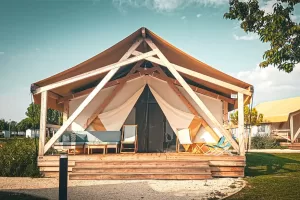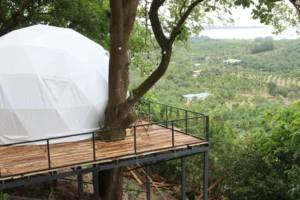introduzione
The glamping industry is rapidly expanding as more people seek luxurious yet nature-filled travel experiences. For entrepreneurs, this shift presents an exciting opportunity to enter the glamping business. Whether you’re curious about the best glamping tents or searching for unique glamping ideas, launching a glamping site requires careful planning and a creative approach. This article will explore essential steps for starting a glamping business, tips on selecting the right tents, and innovative ideas to make your site stand out in the growing market.

Understanding the Glamping Industry
Definition and Evolution of Glamping
“Glamping” is a blend of the words “glamorous” and “camping,” offering the adventure of outdoor camping with the comfort and amenities of a high-end hotel stay. Over the past decade, glamping has evolved from a niche market into a mainstream vacation option, especially among travelers looking to reconnect with nature without sacrificing comfort.
Glamping can range from simple, eco-friendly accommodations to extravagant tented resorts with all the luxuries one might expect from a five-star hotel. The demand for this experience stems from the desire for more personalized, unique vacations, particularly among millennials and eco-conscious travelers.
Market Trends and Target Audience
The global glamping market is projected to grow significantly, driven by trends such as sustainable tourism, the rise of staycations, and the appeal of social-media-worthy travel experiences. Target audiences for glamping businesses typically include:
- Millennials: Known for valuing experiences over material goods, this generation seeks Instagram-worthy, eco-friendly vacations.
- Families: Parents looking for child-friendly outdoor experiences with modern comforts.
- Couples: Romantic getaways in secluded, luxury surroundings.
- Eco-conscious travelers: Guests drawn to environmentally sustainable travel options.
With these groups in mind, entrepreneurs must create experiences that cater to their preferences while ensuring sustainability and innovation.

How to Start a Glamping Business
Initial Research and Planning
Before launching a glamping business, conducting thorough research is crucial. Here are some key steps to take:
- Assessing Market Demand: Understanding the demand in your chosen location is vital. Research travel trends in your area to determine if there’s an interest in glamping. Consider factors like proximity to popular nature spots, ease of access, and existing accommodations.
- Identifying Competitors: Research other glamping sites in your area or niche. Identify their strengths and weaknesses to find opportunities for differentiation. Offering unique themes, better services, or a more personalized experience can help set your business apart.
Legal Considerations
- Permits and Zoning: Glamping businesses are often subject to zoning laws and require various permits. These may include land use permits, environmental impact assessments, and health and safety regulations.
- Insurance: Adequate insurance is crucial for protecting your business from liabilities, such as guest injuries or property damage. Consult with an insurance provider who understands the nuances of outdoor accommodation businesses.
Budgeting and Financial Planning
- Upfront Costs: Initial expenses for a glamping business can vary greatly depending on location, the number of tents, and the level of luxury offered. Major costs include purchasing land (if necessary), constructing infrastructure (water, electricity, and sanitation), and buying glamping tents and furnishings.
- Ongoing Expenses: Recurring costs will include maintenance, staff wages, utilities, insurance, and marketing. It’s essential to create a detailed budget to ensure that you can cover both startup and operational costs until the business becomes profitable.
Choosing the Right Glamping Tents
Your glamping tents are the heart of your business. Choosing the right type of tents is essential to provide the comfort and aesthetic appeal your guests expect.
Popular Types of Glamping Tents
- Bell Tents: One of the most popular choices for glamping due to their iconic shape, ease of setup, and spacious interiors. Bell tents are great for couples and small families.
- Yurts: Originally used by nomads, yurts are durable, weather-resistant, and ideal for year-round use. They can be outfitted with insulation, wood-burning stoves, and other comforts.
- Tende da safari: These large, canvas tents resemble African safari lodges and provide a luxurious feel. They are perfect for upscale glamping experiences.
- Geodesic Domes: Futuristic and highly Instagrammable, domes offer a unique guest experience. They are visually striking and can be adapted for various climates.
Factors to Consider When Selecting Tents
- Durability: The materials used in your tents should be able to withstand various weather conditions. Canvas tents are durable, while synthetic options may offer better water resistance.
- Size and Layout: Ensure your tents are spacious enough for guests to move comfortably. Consider different layouts to accommodate couples, families, or groups.
Customizing Tents for Comfort and Luxury To elevate your glamping business, you’ll want to add luxury touches. Consider offering:
- Comfortable Furnishings: Invest in quality beds, cozy linens, and stylish furniture. You can also include rugs, chairs, and small tables for added comfort.
- Bathrooms and Amenities: Some glamping businesses provide en-suite bathrooms, while others may offer communal facilities. Make sure your bathrooms are clean, well-designed, and easily accessible.
- Eco-friendly Options: Use sustainable materials and energy-efficient amenities to appeal to eco-conscious guests.

Creative Glamping Ideas to Set Your Business Apart
To succeed in the glamping business, you’ll need to offer more than just a pretty tent. Innovative ideas will set you apart from competitors.
Themed Glamping Sites
- Eco-Glamping: Cater to environmentally-conscious travelers with a focus on sustainability. Use renewable energy, offer composting toilets, and emphasize minimal environmental impact.
- Luxury Retreats: Offer high-end glamping experiences with amenities like hot tubs, gourmet meals, and spa treatments.
- Adventure-Based Glamping: Create a glamping site that appeals to adventure seekers with activities such as hiking, rock climbing, or water sports.
Incorporating Unique Guest Experiences
- Outdoor Activities: Provide guided nature walks, stargazing nights, or outdoor cooking classes to give guests more value and create lasting memories.
- Wellness Offerings: Tap into the growing wellness tourism trend by offering yoga classes, meditation sessions, or outdoor spa treatments.
Building an Instagram-Worthy Glamping Site In today’s social media-driven world, creating a visually appealing glamping site can boost your marketing efforts. Focus on:
- Design: Use beautiful, natural materials and striking color schemes to create a photogenic environment.
- Lighting: Set the mood with fairy lights, lanterns, or solar-powered lights to create a magical atmosphere at night.
- Social Media Friendly: Encourage guests to share their experiences by creating photo spots or offering incentives for social media posts.
Marketing and Growing Your Glamping Business
Once your site is set up, effective marketing is crucial for attracting guests and building your brand.
Building a Strong Online Presence
- Website Optimization: Your website should be visually appealing, easy to navigate, and optimized for mobile devices. Include high-quality images, detailed descriptions of your offerings, and a straightforward booking system.
- SEO and Google My Business: Optimize your website content with relevant keywords like “glamping tents” or “luxury camping” to improve your search engine ranking. Claim and optimize your Google My Business listing to attract local searches.
Attracting Guests Through Targeted Advertising
- Social Media Ads: Platforms like Instagram and Facebook are great for showcasing the visual appeal of your site. Run targeted ad campaigns to reach potential guests based on demographics and interests.
- Collaborate with Influencers: Partner with travel influencers to promote your glamping site to a broader audience. Influencer endorsements can build credibility and drive bookings.
Managing Reviews and Guest Feedback Positive reviews are vital for building trust and attracting more guests. Encourage satisfied visitors to leave reviews on platforms like TripAdvisor, Google, or your social media pages. Responding to feedback, both positive and negative, helps you maintain a good reputation and shows that you care about your guests’ experiences.

Sustainability in Glamping
Sustainability is becoming increasingly important to travelers. Integrating eco-friendly practices not only appeals to this growing market but can also help reduce operational costs.
Eco-Friendly Tents and Amenities
- Use tents made from natural, sustainable materials like cotton canvas, bamboo, or recycled components.
- Incorporate energy-efficient options such as solar-powered lighting and heating, and offer composting toilets to reduce water waste.
Attracting Eco-Minded Travelers Eco-conscious guests are often willing to pay more for sustainable experiences. Highlight your green initiatives in your marketing materials, from energy-efficient infrastructure to your support of local environmental causes.
Conclusione
Starting a glamping business offers a unique opportunity to combine hospitality with outdoor adventure. By selecting the right glamping tents, embracing creative ideas, and focusing on sustainability, you can create an unforgettable experience for your guests while building a profitable venture. With careful planning, strategic marketing, and a commitment to providing high-quality accommodations, your glamping business can thrive in this rapidly growing industry.




